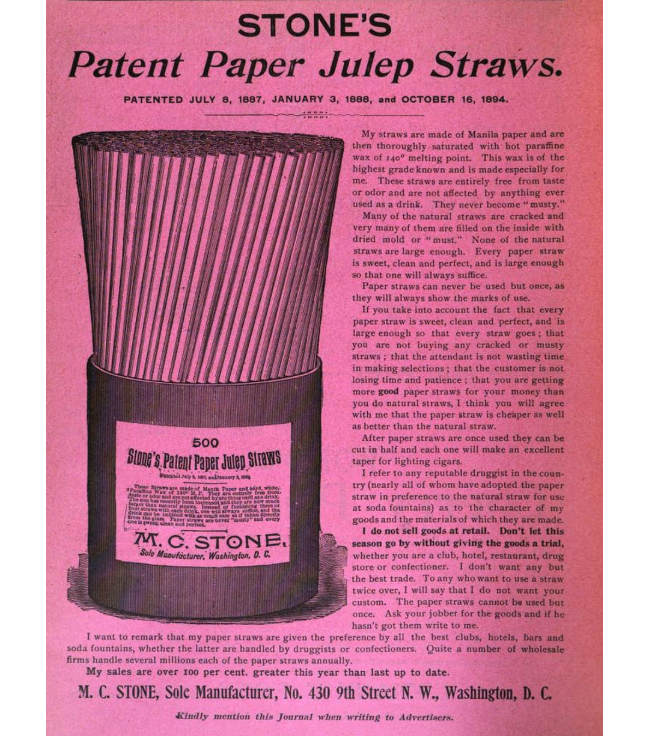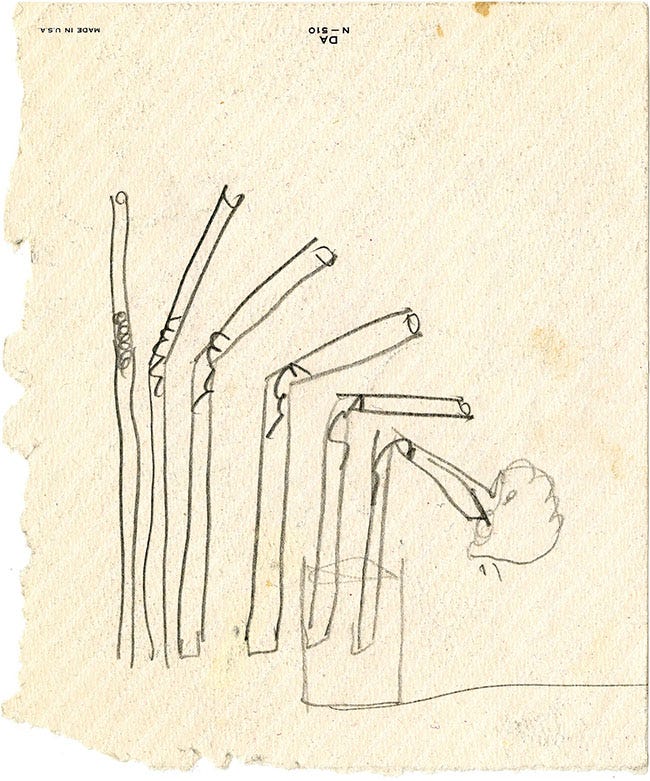A Brief History of the Drinking Straw
January 3 is National Drinking Straw Day. As sundry forces conspire to make the plastic drinking straw an endangered species, let's take a trip down memory lane and find out why it became so popular in the first place.
January 2, 2024

The days when we will be able to sip a “tasty beverage” through a plastic straw seem to be numbered. Iconic brands, cities, and even countries have joined the crusade to “stop sucking.”
There has been some pushback on these bans, notably from the disabled community, where straws can be a lifesaver. Critics of the movement to rid single-use plastics from our lives also note that plastic straws, in the grand scheme of things, are not the great Satan. Activists retort that straws are a “gateway issue to help people start thinking about the global plastic pollution problem,” Plastic Pollution Coalition CEO Dianna Cohen told Business Insider. "They've been designed to be used for a very short amount of time, and then be tossed away," she said.
Like the plastic bag ban that swept through supermarkets, the plastic straw ban has taken on a momentum of its own. Banning the ban is probably not a battle worth fighting, frankly. And I have to say that environmental activists have some points. I was astonished to learn that Americans use 500 million drinking straws every day, according to statistics referenced by the US National Park Service. That’s more than one and a half straws per person per day! I tried to make a mental calculation of how many straws I use in any given week, and came up with two.
The question, then, is what do we replace them with? Paper, glass, and stainless-steel straws all have their drawbacks. One company has developed a reusable plastic straw — the Tfees straw — which is injection molded from Eastman’s Tritan co-polyester material. It’s dishwasher safe and transparent, so that you can visually verify its cleanliness. It would seem to be a viable solution, unless you’re an ideological purist. “In trying to market her product to various restaurants and bars, she is being told that they are going ‘plastic free,’ which means they can’t use her reusable plastic straw, even though it’s an ideal alternative to a paper straw,” Clare Goldsberry reported in PlasticsToday a couple of years ago.
You can’t win. But let’s have a bit of fun, anyway, and fire up Mr. Peabody’s Wayback Machine to learn about the evolution of the drinking straw.
First stop: A Sumerian tomb circa 2000 to 3000 BC
The earliest known drinking straw, according to some historians and archeologists, was found in a Sumerian tomb from 2000 to 3000 BC. Made of gold and precious stones, the straw probably was used to drink primitively fermented beer, in which solid byproducts sank to the bottom as the drinkable fluid floated on top. We’ve made some advances in brewing beer since then, but three-star Michelin restaurants that provide straws to diners — there must be some, right? — might take a page from the Sumerians’ book if they decide to go plastics free and up their prestige in one fell swoop.
Flash forward to 1880 and the invention of the paper straw
Legend has it that Marvin Stone was drinking a mint julep on a hot summer day in 1880 when the straw, made of rye grass, started to disintegrate. An entrepreneur who had some success with his invention of a paper cigarette holder, Stone wrapped strips of paper around a pencil, glued them together, and soon had an early prototype of paper drinking straws.

Image courtesy of Wikipedia (https://en.wikipedia.org/wiki/Marvin_Stone#/media/File:Advertisement_for_Stone_Julep_Straws.png)
"He patented his design in 1888, and by 1890, his factory Stone Industrial . . . was mass producing them,” explains an article, “A Brief History of How Plastic Straws Took over the World,” published in National Geographic.
Yankee ingenuity and the bendy straw
In the 1930s, serial inventor Joseph B. Friedman was watching his young daughter, Judith, struggle with a straw as she tried to sip a milkshake at a soda fountain in San Francisco. There had to be a better way, thought Friedman. Writing for the Atlantic, Derek Thompson describes what happens next in “The Amazing History and Strange Invention of the Bendy Straw”:
“Friedman inserted a screw into the straw toward the top. Then he wrapped dental floss around the paper, tracing grooves made by the inserted screw. Finally, he removed the screw, leaving an accordion-like ridge in the middle of the once-straight straw. Voila! He had created a straw that could bend around its grooves to reach a child's face over the edge of a glass.”

Joseph Friedman's sketch showing the bending mechanism of his flexible straw. Image courtesy of Joseph B. Friedman Papers, Archives Center, National Museum of American History.
Freidman established the Flex-Straw Co. in 1939. Soda fountains were not his first customers, however. That distinction rests with hospitals, where patients were still using rigid, not to mention breakable, glass tubes. “Nurses realized that bendy straws could help bed-ridden patients drink while lying down,” recounts Thompson. “Solving the ‘Judith problem’ had created a multi-million dollar business.”
One word . . . plastic
In the 1960s, plastic replaced paper at warp speed, and fast-food culture played a fundamental role. Plastic straws were cheap, durable, and they would not tear apart as you pushed them through the crosshairs of to-go cups, also made of plastic.
Those were the days, my friend. . . .
About the Author(s)
You May Also Like




